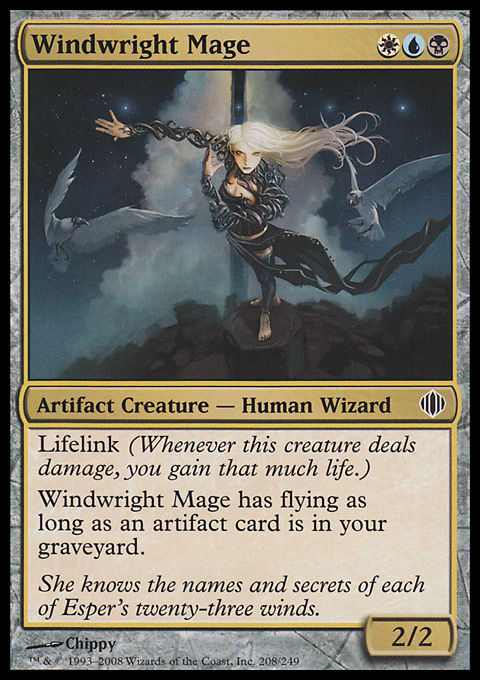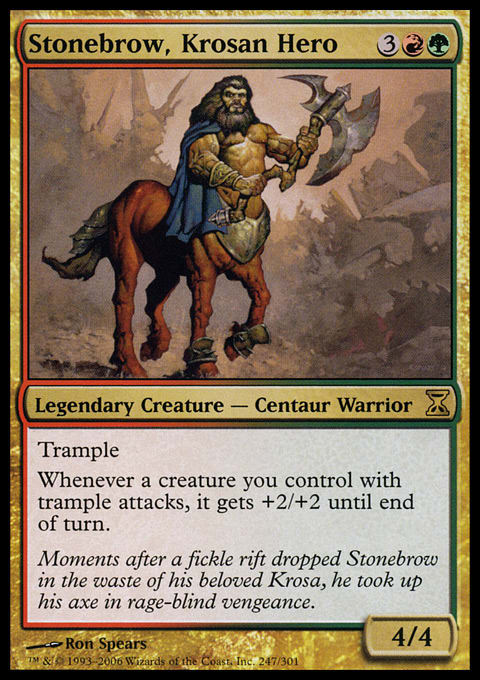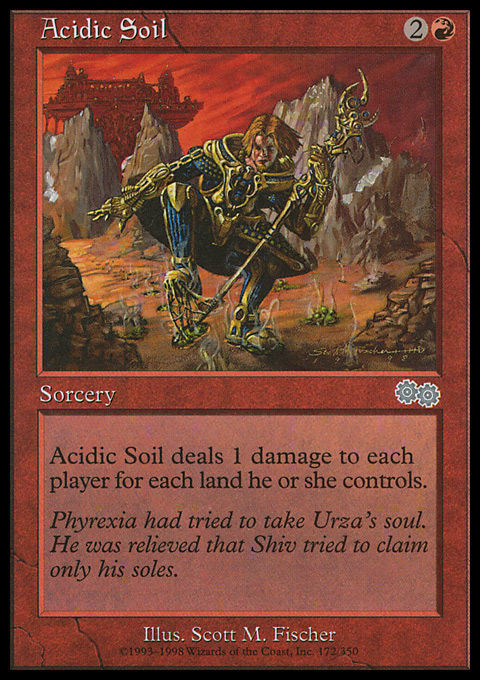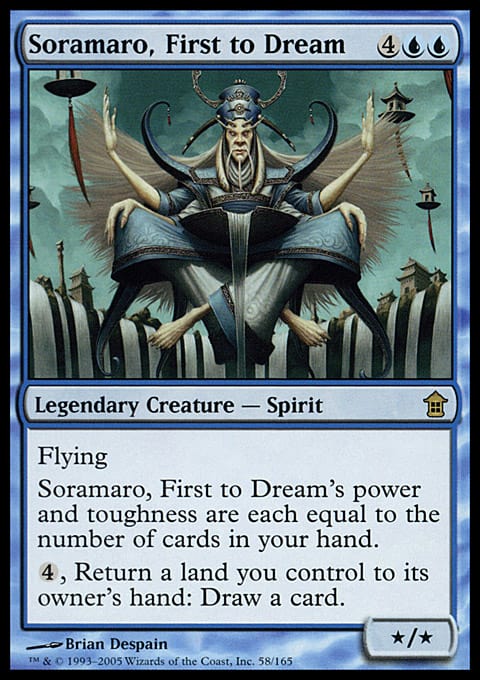Every multiplayer game I’ve been a part of over the last month has been defined primarily by deck colors, whether by presence or absence. Almost without exception, the best games have featured a balance of colors, while the worst games were the ones in which every deck’s colors seemed the same. I don’t know how normative my recent experience is, but if you’re finding your recent play night’s a drag, see if this issue’s coming up for you and see if a fix—play a by-the-rules Star, get someone to change decks, or something else; I don’t care—is in order.
How Does It Matter?
The best Magic games unfold like a narrative. The decks are the characters, and their individual traits interact with each other in a way that, like an actual story, features tension and resolution, rising and falling, and an end that flows from the plot. I don’t mean in the overly archetypal way that Mark Rosewater views storylines; you don’t have to play to expectations of who wins and who loses or anything like that. But there is a basic sense in which a deus ex machina feels like it’s obviating the previous hours watching or reading a thing. Reading twenty chapters of a gritty crime novel to find out it was aliens the whole time will be stupid every time—not because innovative plots or unexpected things shouldn’t happen, but because there was literally no payoff for your investment in the plot.
Strategy games have the same desire for a narrative. A hard-fought creature battle that ends on the umpteenth turn when Mr. or Ms. Combo, who hasn’t been doing anything the whole game, drops all the pieces at once for the win is in many ways the same evisceration of plot that aliens is to a crime novel. I think this, more than anything Commander players tend to say or write, is why infinite combos often get the banhammer; it’s a primitive method of ensuring a properly flowing narrative.
So, what do deck colors have to do with this? As a general rule, a multiplayer game with all colors presents a greater chance for meaningful interaction—decks naturally answering each other rather than playing solitaire. If everyone in a sitcom behaved identically, there wouldn’t be that many situations or much comedy. Even an inaction film like Napoleon Dynamite needed varied characters to advance the story.
Consider Shards of Alara, in which each shard knew only its own magic. Esper, devoid of red and green, decided that becoming part artifact was the path to immortality. For what they knew, it was. Naya, devoid of blue and black, was full of big unstoppable creatures. Lacking certain fundamental forms of interaction, each shard gained an identity that in its world made perfect sense.
If a multiplayer game’s deck colors are basically one shard, the game’s going to resemble that shard in many ways. If nobody’s playing red or green, artifacts have a very good shot of taking over. If nobody’s playing blue or black, that big monster you hate in your opponent’s deck may win the game without interference. The colors make the environment, and the environment makes the game, and your narrative may skew unpleasantly if something’s missing.
Oversaturation
A couple weeks ago, I played Commander with Trick Jarrett, editor of DailyMTG.com and former honcho round these parts, and two other guys, Mark and Dylan of some spelling (I never asked). We played three games over two hours, and the colors involved shaped not only the interactivity—the game narrative, so to speak—but the length of the game. All the games were fun since Trick, Mark, and Dylan are cool people, but not every game was equally full of real game. Clockwise starting with me:
Game 1
Me: Karador, Ghost ChieftainMark: Sen Triplets
Dylan: Stonebrow, Krosan Hero
Trick: Kiki-Jiki, Mirror Breaker
Every color’s represented twice except for blue, which shows up once. Dylan made it an Archenemy game for a while with Sol Ring, as it ramped into Spawnwrithe on turn two and Stonebrow on turn three. Damage and Spawnwrithes flowed freely.
I saved Mark a turn with Aether Shockwave, but I never got my mana sorted out and wasn’t much of a player in the game. Mark was interacting pretty well, while Trick eventually got silly with Kiki-Jiki and Siege-Gang Commander with just enough Stingscourger thrown in for disruption.
The bulk of the action was Dylan’s and Trick’s, but I was 1 mana away from Kirtar's Wrath for several turns and would have answered the board effectively with it. (The Celestial Kirin and Elder Pine of Jukai in my hand would have answered things as well, but the mana was an issue again. How many times are you glad you drew Elder Pine of Jukai?)
Game 2
Mark: Sen Triplets
Dylan: Zedruu the Greathearted
Trick: Grimgrin, Corpse-Born
There’s no green, and everybody’s blue. This game was about twice as long as the first one, and not in a good way. You could say we were interacting, but we weren’t; we, like the Knowledge Pool, had all the answers—especially “no.” (Have you ever wanted to Override my puns?)
Dylan played an on-curve Tsabo's Web, which was fine with me as my deck had no nonbasics, but Mark’s Strip Mine, which he needed for mana, was shut down . . . until I played Quicksilver Fountain and turned his Strip Mine into a sometimes-Island. (This also gave Trick mana from his Temple of the False God a turn early, strangely enough. Quicksilver Fountain is king of the group hug.) The Fountain stopped Dylan and Trick from casting their intended cards, while Mark sometimes got blue mana – blue mana I eventually stopped with Back to Basics.
All these cards were doing a great job of shutting down opponents, but they also weren’t advancing the game whatsoever. Restricting everyone to blue mana kept anyone from answering the noncreature permanents effectively, so we sat around a lot. The game dragged on as we just wanted something—anything!—to do. Trick cast the same Increasing Ambition about five times—not from any cool ability, but from take-backs from forgetting Dylan’s Mindlock Orb. The same was true of his Terramorphic Expanse, which could have sacrificed itself for no benefit.
Eventually, Trick brought Grimgrin and Mikaeus, the Unhallowed out, which would have become nasty except for Dylan’s Pithing Needle for the former and my Phyrexian Ingester for the latter. While these were necessary plays, they weren’t exciting plays; they just felt as though they were prolonging the misery. I’m not sure how the game ended, but it involved Mark’s Master Transmuter and Blightsteel Colossus against Trick’s Phyrexian Metamorph and Grimgrin.
Game 3:
Mark: ???
Dylan: Heartless Hidetsugu
Trick: Grimgrin, Corpse-Born
After that epic (in length, not in awesomeness), Dylan decided to speed things up; I agreed and chose my deck accordingly. It turns out that we didn’t need two players choosing to speed up. Dylan prefaced his Heartless Hidetsugu with Manabarbs. We decided to play spells anyway, just to do something against Dylan. This might have worked, except Dylan followed his Hidetsugu activation with Acidic Soil. This game didn’t last even ten minutes, which is why I don’t remember Mark’s deck.
Basically, when the color representation was off, so were the games. We had an over-blue game and an over-red game, and each was ugly in its own way. Although I was less a player in Game 1, it had the best narrative, as each deck had an out to each other deck. The other games felt as hopeless as reaching the end of Ayn Rand’s The Fountainhead; you could do it, but the reward’s incredibly limited—you wind up detesting everything about it. (I might be bitter about having to read it in high school.)
The Brothers’ War
The night above was the inspiration for this article, but it helped me correct a problem from a couple nights earlier. In a five-way, sixty-card game going clockwise:
Week One
Me: W/U Wormfangs (life-gain, ETB abilities, slow advantages into a Dimensional Breach)
Nate: W/B Spellshaper control (Cho-Arrim Alchemist, Insidious Dreams, random things)
Brother 1: U/B Zombies with Rooftop Storm, Mind Unbound, and Elixir of Immortality
Brother 2: U/B Zombies with Rooftop Storm, Mind Unbound, and Elixir of Immortality
Mike: Mostly colorless Eldrazi ramp with a smidge of black
I don’t know the brothers’ names or even entirely if they’re brothers, but that’s not a misprint on their decks. They were playing almost the exact same deck. Brother 1 splashed red for Flayer of the Hatebound, but that was about the only difference. The Zombie decks became so ridiculous that Nate and I were relieved Mike cast Emrakul, the Aeons Torn. Annihilator would have been great . . . except it was going against a freshly cast Army of the Damned.
After Emrakul annihilated and Nate Plague Winded, the game went to Mind Unbound and Rooftop Storm, with Brother 2 getting Mind Unbound to 8 counters and dropping free Zombies everywhere. We non-brothers had no permanent way of dealing with the card advantage, and we didn’t draw our temporary ways. It was long, drawn out, and generally deflating.
The next week, I was about to face those brothers again in a four-way game my wife joined in. I didn’t expect the brothers to play those same decks again automatically, but just in case they did, I chose accordingly:
Week Two
Me: Kavu Predator/Fiery Justice
My wife: G/U “wisdom” (Soramaro, Masumaro, Overbeing of Myth, and all cantripping instants)
Both brothers: Same Zombie decks as before
This time, however, they were against colors that could deal with them. I came out swinging with Kavu Predator and Swords to Plowshares and Fiery Justice for the first threats I saw. My Kavu Predator met Call to the Grave; I Swordsed my own Predator just to deal with the enchantment before Zombies happened.
My wife played her deck as it’s intended—dropping Spellbook and early rattlesnakes Carven Caryatid, Jungle Barrier, and Aetherplasm until she was good and ready to do something.
When Mind Unbound showed up, she had the Rending Vines for it. When I had Wild Pair, Brother 2 had Sever the Bloodline for my duplicate-fetching Oakgnarl Warriors.
Not long after I died—playing colors that answered two decks didn’t make me popular, after all—Brother 1’s Flayer of the Hatebound from Brother 1 attacked my wife, at which point she blocked with Aetherplasm and brought in a 22/22 Masumaro, First to Live. Shadow Rift on one turn and Wildsize the next spelled doom for the brothers on successive turns, but it wasn’t from combo land so much as it was playing good defense while the rest of us were on high-offense plans.
The Point of the War Stories
While I was able to fashion narratives around all these games, the ones with more balanced colors were about how we dealt with each other’s threats, while the skewed games were about how we didn’t. Just like how a book is more involved if its characters interact with each other than if they all have separate plotlines, so a game narrative is better if the decks are affecting each other. It doesn’t automatically happen by balancing colors, but the color pie is optimized for interaction, and ensuring the whole pie shows up gives more chances for things you’ll want to remember instead of events you can’t seem to forget.





























